Edie Melson's Blog, page 61
February 14, 2024
Writers Conference 1101: Ten Tips to Maximize Your Return

by Lilka Raphael @Lilka_Raphael
Conference season is upon us. Investing in writing conferences is by far the smartest thing I have done to refine my writing. Publishing trends and challenges evolve. Appointments with editors, informative classes, and connecting with other writers yield an invaluable return on the time and money spent attending.
Here are my top ten tips to make the most of any writing conference.
1. Choose wisely. I attended a large conference for years. Though I learned much, I would be farther along in my writing career if I had first researched various conferences. The editors and agents interested in the devotions I write are most likely attending a Christian conference rather than a broader one soliciting the next thriller or sci-fi fantasy. There are conferences available for practically every genre. Select a conference that has editors, publishers, and classes that specialize in what you write.
2. Dress the part. Most conferences encourage comfort. However, a tidy appearance demonstrates that you value the time of the people you meet. You can even dress in a theme if it ties into the project you are pitching. But don’t be outlandish. You want recognition for all the right reasons.
3. Invest in business cards. This goes back to recognition. Your business cards don’t have to be expensive. Your name, photo, and email will suffice. If you have a novel to promote or accolades to note, add those as well. But keep it simple. The card should be easy to read and uncluttered.
4. Enter a contest. Most conferences will have at least one. The deadlines are usually a month or more prior to the conference. Writing to compete made me scrutinize word choices I would otherwise overlook. It also forced me to work toward a deadline. This straightforward exercise can generate valuable feedback. Recognition for your work will also motivate you to write more.
5. Pay for a critique or mentoring. For the price of dinner, you can gain access to a professional. If you have an appointment, do your research. Not only will you feel prepared, but you may identify important questions to ask. Pinpoint professionals that work with your genre. You can find their preferences on their individual sites. Do not pitch your historical thriller to someone seeking nonfiction unless requested to do so. The advice and continued mentoring I have received was well worth the nominal fees.
6. Take the pressure off. It is possible to walk away from a conference with a book contract, but it is highly unlikely. Instead, prioritize the classes and meeting people. Make note of any comments or ideas that you can apply in your work. Conferences should be educational and enjoyable. Allow time to laugh and relax.
7. Mingle. The best advice I received at my last conference came from a seasoned devotional writer. She suggested that I meet as many professionals as possible. You may not have lunch with the rock star agent everyone is anxious to pitch. However, you can learn a great deal from publishers and agents with available appointments and extensive knowledge. I have found that they are eager to help new authors. Networking might allow you to supersede a backlog of submissions and get your work in front of a publisher. You can never anticipate how these connections will benefit you later. A conference is a safe environment to meet people in the industry.
8. Pace yourself. My favorite conference is also the largest one I attend. The opportunities are endless. However, I manage my activities, so I’m not overwhelmed. Carefully, select the classes and speakers that will benefit you. Do not overschedule. Exercising restraint allows you to leave the conference revitalized instead of exhausted.
9. Be yourself. You don’t have to emulate a best-selling author to succeed. If you start off exuberant but you are actually laid back, it will prove impossible to maintain that façade. Industry professionals want to meet your authentic self. Your words are valuable and so are you.
10. Give thanks. Words of gratitude are rare even among writers. One publisher continued to mentor me long after the conference was over. Acknowledging their time and comments may help you develop a professional relationship. Writing is a solitary endeavor, yet it takes a village to get our words out among the masses. Gratitude goes a long way toward building a community that we can learn from and contribute to in return.If you cannot attend a conference this year, prepare now for 2025. Identify the conferences that provide the best opportunities for your genre. In the interim, take a class or attend a workshop. Consider entering an online contest or two. We should continually strive to hone our skills. The best investments we can make to improve our writing is investing in ourselves.
TWEETABLEWriters Conference 1101: Ten Tips to Maximize Your Return from @Lilka_Raphael on @EdieMelson (Click to Tweet)
 A Florida native, Lilka Finley Raphael has been a licensed pharmacist for over thirty years. Her passions for writing, gardening, and photography prompted her to share her experiences and life lessons on her blogs B Is for Blessed and God, autism, & me. You can learn more about her at lilkaraphael.com
A Florida native, Lilka Finley Raphael has been a licensed pharmacist for over thirty years. Her passions for writing, gardening, and photography prompted her to share her experiences and life lessons on her blogs B Is for Blessed and God, autism, & me. You can learn more about her at lilkaraphael.comLilka’s greatest achievements are her two adult sons who have flown the nest. Happily married for thirty-two years, she lives east of Atlanta with her husband, Rod. They now share their home with two German Shepherds—Holly and Ivy—and one naughty kitty, Moxie.
Published on February 14, 2024 22:00
February 13, 2024
This Year Give Yourself the Gift of a Writing Conference
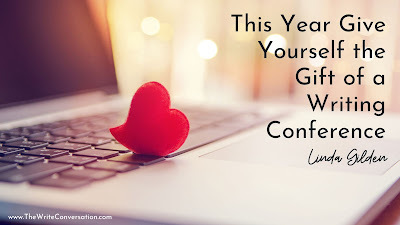
by Linda Gilden @LindaGilden
Today is Valentine’s Day. This is always special for someone who has a Valentine. But for those who don’t, I would recommend doing something for yourself that you love to do but might not otherwise take the time or money.
I could make a lot of suggestions. You might like to play golf, swim in a nearby lake, have lunch with your sweetie, or take a short road trip to visit someone you haven’t seen in a long time. For me, however, whatever I love to do would have something connected to with writing.
The Carolina Christian Writers Conference is coming up in just a few weeks. Maybe you feel the same way about writing. Why not join us March 8-9 to spend a few days around like-minded people?
The first time I went to a writing conference, my children quickly called their dad. “Dad, come here. Mom is so happy. She must have been to ‘writers paradise.’ Let’s let her go again sometime soon.’”
But my Valentine wish for you is if you are a writer, you can join us in Spartanburg, SC the second week of March. I will be there with our publishers, editors, agents, and freelance writers and spend those few days learning from them.
My Valentine gift is to give you a few pointers that will help things go more smoothly.
Tips to Make the Most From a Writing ConferenceMake a list of your goals for the conference. Dream big.Pray. Once you have your list made, commit that list to God. You can always trust Him to help your dreams come true.Memorize a thirty-second pitch of the project you are most passionate about. You want to be able to answer confidently and passionately when someone asks, “What are you working on?” Make or purchase some business cards. You will look very professional, and you don’t have to wait for a publisher to write down your information. It’s much quicker to hand them a business card. Business cards are easy to stick in your pocket and then put in a file when you get home. Make sure you put your picture on it so editors and professionals can remember you.Buy an empty notebook to take notes in. I prefer a steno notebook. It fits easily in my bag or purse, and you can easily give a whole page to those you meet with. Before I get to the conference, I study who will be there and what they publish and see if the things I have to offer match any of their needs.If you don’t have a full proposal, make a one sheet of your current work-in-progress. If you don’t know what a one sheet is, email me at linda@lindagilden.com and I’ll send directions or do an Internet search. It’s simply one sheet that gives someone looking at your idea a way to have all the information in one place.Even if you are an introvert, be prepared to meet new people and chat writing with others. If you have questions about writing, find someone who seems to know the subject and ask your question. If you become overwhelmed, go to your room, or find a quiet corner to take a few minutes and rest. Then when you are ready, jump back into the excitement of the conference.
I hope to see you at the conference. All information is on our website – www.fbs.org/writers. If you’ve never been to a writing conference, maybe you’d like to try it. No matter what you do, may your Valentine’s Day be running over with love and friends as you have a great day.
TWEETABLEThis Year Give Yourself the Gift of a Writing Conference from @LindaGilden on @EdieMelson (Click to Tweet)
 Linda Gilden is an experienced, bestselling writer, speaker, award-winning editor, marketer, and speaking coach, ghostwriter, and writing coach. Author of 40 books and 2,000+ magazine articles, Linda appreciates a great story. She believes with our stories, we can change the world one word at a time and loves to encourage others to do that through writing coaching and personal tutoring. Her newest book was released in November: TRADING SHADOWS: EXCHANGING A LIFE OF SECRETS, FEAR, AND DOUBT FOR A LIFE OF FREEDOM WITH THE ALMIGHTY.
Linda Gilden is an experienced, bestselling writer, speaker, award-winning editor, marketer, and speaking coach, ghostwriter, and writing coach. Author of 40 books and 2,000+ magazine articles, Linda appreciates a great story. She believes with our stories, we can change the world one word at a time and loves to encourage others to do that through writing coaching and personal tutoring. Her newest book was released in November: TRADING SHADOWS: EXCHANGING A LIFE OF SECRETS, FEAR, AND DOUBT FOR A LIFE OF FREEDOM WITH THE ALMIGHTY.
Published on February 13, 2024 22:00
February 12, 2024
Timelines and Plotting Your Novel
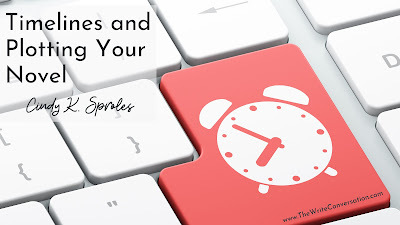
by Cindy K. Sproles @CindyDevoted
Timelines can be tough. I struggle with dates myself. Every writer has a weakness, and the key to becoming a truly proficient writer is to address the weaknesses and learn methods to help strengthen you. For me, it’s dates in a timeline.
When publishers ask me for a timeline, I do my best to provide and then as editors begin to work through the novel, they’ll call my hand on a spot where the line isn’t clear. Thank goodness, I’ve never had them say, “This doesn’t work.” The hitch in my giddy-up is usually how many days have passed.
As I spent some time on my newest work, charting my timeline, I realized I never learned this at a conference. I can’t remember anyone ever addressing what this was or its value to my novel, so today, we’re going to touch on my weakness, nemesis—the timeline in a two-part post.
You know that life is not a straight line. Point A doesn’t always lead to Point B. It may jump to Point C. Things happen, and the cause and effect of those things brings about more events—rabbit trails. In the writer’s head, these things happen progressively, and we get it. But sometimes, this causes us to forget the reader. We may write an event, then in the next scene, forget to show the effect or timeframe of the event, and leave our reader asking, “But what about…” When we see cause and effect, suddenly, we see how important it is to tie things together. And this is what a timeline does. It helps us to see twists, story progression, and even character patterns.
So, how does that mumbo jumbo help you with a timeline?
Think of it like this: A timeline suggests the past, present, and future in our story. Plotting along our timeline helps us see our beginning, middle, and our desired end. The timeframe helps us maintain that every day that passes matches the times we said they would. If little Johnny is ten when his mother dies, we must use our timeline to maintain that throughout the story. We don’t have him on a family trip enjoying Mom if she is supposed to be in the hospital dying.
Here are a few things to help you create a good timeline for your novel.
I suggest you keep a notebook next to your computer and jot down the primary points your story needs to develop a good timeline. As you add these things to your story, write them down. You should be able to follow time, incidents, and resolutions by the time you reach the end of your story. Everything should tie together because you’ve listed them, answered any questions, and closed any gaps your reader may have.
Age: Readers need to know how old our characters are when the story steps off and where our characters are at the end. Did our protagonist begin her journey as a teen and complete it in her thirties, or was it only months from beginning to end? Readers need to see exactly where our characters are age-wise. This helps with the believability of the story.
Inciting moment: I once sat in a class by master novelist and plotter James Scott Bell where I first heard the words, inciting moment or incident. His best explanation still hangs on my computer. It was a question. Why does this story start? Not where or how, but why? What is the one incident that tips our protagonist over the edge and forces them to begin their journey or adventure? Write it down.
The WHERE: This is hard for us because we assume our readers magically know where our characters stand in the story as it begins, but they don’t. They need a hint. The where is not necessarily location, like a house or a city (though we need this too), but it’s the moment in their life when this story begins. Not backstory. We don’t need a full historical account of how our character got to this point. We only need where they are emotionally. That explosive internal emotion which gives them the courage to change their circumstances. The rest will follow. This is why our first chapter, first paragraph, and first page are vital. If we can draw our readers in with minimal telling but show the emotional state of our character, then they are hooked. They should ask the question: What on earth is going on here?
My eyes focused as best they could. “Stately!” I shouted. “Stately!” In our fifty-some years together, I hardly ever caught the man sittin’ still. Something was wrong. My breath hung.
This first line shows fear and a hint of the character’s age. This shows us our character is—fearful and scared, and it begins to tell us that something is about to force a change in this character's life. Our readers now see the beginning of our timeline and where this story begins in the life of our character.
Story goals: What are your goals for your protagonist? Will they make a life-changing decision and work through a maze of trials to find the answer to their why? What are the goals for your character in this story, and what would you have them successfully complete by the end? Questions are the key here. Ask them. Write them down and answer them. You need them to move your story correctly through time.
Secondary Characters: Who are those secondary characters who play a major role in the life of your protagonist, and what are their motives? Are their motives to be a support, or do they have ulterior motives that cause issues? Be sure and write these down and track them through your writing. Are these characters meeting the expectations you placed on them? Are they accomplishing your goal for their motives? As you write your protagonist’s road, these side stories, or secondary plotlines, must continue to follow the timeline our character is in. In other words, Sally (our protagonist) must find her sister by the end of the story, and Joe, her friend, doesn’t want Sally to find the sister because… As Sally works through the events to find her sister, are Joe’s attempts to stop her following in the same day, week, or month? Every incident has to fall within the period of time we have set for our story from beginning to end. If it is a childhood event, have you made sure the ages and times fit? If something falls out of line, a hole forms in the story, and it could be a black hole, meaning rewrite.
Age: yet again! How old are our characters at the end of the story? Are they following the timeframe you set in the beginning? In the snippet you saw above, the characters are obviously elderly since they’d been together fifty-some years. They can’t live another fifty years, so we must be sure their ages follow their age in the beginning. As you read the story above, you’ll learn it takes place over one year, and the protagonist is 94. Her physical timeline battles the timeline of the story, and the question arises: will she survive the inciting incident that set her on this path? You’ll have to read This is Where It Ends to find out, but the point is, this story, from beginning to end, fights against time, so every incident from the past, present, and what is to come must fall perfectly in a one-year period.
The end: You’ve typed those amazing two words, and you feel good right now. BUT, does everything fall into place? Did your characters meet your expectations? Are their ages correct by the end? Do all the twists, turns, and incidents line up in time and in the time frame you’ve set for your story? Have you answered all the questions and made sure that the rabbit trails (secondary plots) are falling in the correct time sequence? And who said writing a novel was easy?
Take time to write this list of items down to help you begin to create a solid timeline. You’ll need this for your publisher when your story is contracted. Next month, in part two, we’ll address the beginning and ending of your story. The clock is ticking. Where’s your timeline?
TWEETABLETimelines & Plotting Your Novel from @CindyDevoted on @EdieMelson (Click top Tweet)
 Cindy K. Sproles is an author, speaker, and conference teacher. Having served for a number of years as a managing editor for Lighthouse Publishing of the Carolinas and Ironstream Media, Cindy now works as a mentor, coach, and freelance editor. She is the co-founder of Writing Right Author Mentoring Services with Lori Marett and she is the director of the Asheville Christian Writers Conference. Cindy is also the co-founder of Christian Devotions Ministries and WWW.CHRISTIANDEVOTIONS.US, as well as WWW.INSPIREAFIRE.COM. Her devotions are in newspapers and magazines nationwide, and her novels have become award-winning best-selling works. She is a popular speaker at conferences and a natural encourager. Cindy is a mountain girl, born and raised in the Appalachian mountains, where she and her husband still reside. She has raised four sons and now resorts to raising chickens where the pecking order is easier to manage. You can visit Cindy at WWW.CINDYSPROLES.COM or www.wramsforwriters.com.
Cindy K. Sproles is an author, speaker, and conference teacher. Having served for a number of years as a managing editor for Lighthouse Publishing of the Carolinas and Ironstream Media, Cindy now works as a mentor, coach, and freelance editor. She is the co-founder of Writing Right Author Mentoring Services with Lori Marett and she is the director of the Asheville Christian Writers Conference. Cindy is also the co-founder of Christian Devotions Ministries and WWW.CHRISTIANDEVOTIONS.US, as well as WWW.INSPIREAFIRE.COM. Her devotions are in newspapers and magazines nationwide, and her novels have become award-winning best-selling works. She is a popular speaker at conferences and a natural encourager. Cindy is a mountain girl, born and raised in the Appalachian mountains, where she and her husband still reside. She has raised four sons and now resorts to raising chickens where the pecking order is easier to manage. You can visit Cindy at WWW.CINDYSPROLES.COM or www.wramsforwriters.com.
Published on February 12, 2024 22:00
February 11, 2024
Tips to Add Humor to Your Writing

by Larry J. Leech II @LarryJLeechII
Jim Carrey. Adam Sandler. John Belushi. Bill Murray. Kevin James. Chris Rock. Robin Williams. Steve Martin. Tim Allen.
Oh, man. These guys could deliver a funny line like no one else! Combined, they have starred in dozens of laugh-out-loud, nearly-peed-my-pants movies. The list of movies and one-liners would be long, and I’m sure we’d stop and chuckle at a memory from each one.
But, what about humor in your story? Do you consciously avoid it? Interject it? Or does writing a funny quip or story come naturally for you?
If you need help adding humor to your story, don’t fret. You’re in a boat with a lot of other writers. Picking the right kind of humor—sarcasm, satire, self-deprecating humor, and situational humor—depends on the story and character. If you’re not sure if your humor tickles the funny bone, lean on your beta readers, coach, or writer’s group.
Couple of things to keep in mind to help write humor:
Keep your jokes short. Use funny words, humorous stories, and one-liners where it feels right. The wrong word or phrase will make the reader cringe.
Aim for smiles, not laughs. You want to write something that delivers a subtle laugh that lingers.
Use the rule of three. This common rule involves establishing a set pattern with two ideas and then subverting that pattern with a third, incompatible idea. For example, “Can I get you anything, sweetheart? Coffee? Bagel? A divorce?”
We see the rule of three in numerous other places:Life, Liberty, and the Pursuit of Happiness – Rights outlined in the U.S. Declaration of IndependenceStop, Look, and Listen – A public road and level crossing safety sloganSnap, Crackle, and Pop – Cartoon mascots of Rice Krispies
When you write, save the funny word or phrase for the last item in the series. That will ensure the maximum punch.
Use humor in dialogue. This is not only the logical place to add humor, but also will give the reader some insight into the character who delivers the quip, snarky comment, or quick laugh.
Don’t shy away from clichés. Yes, your writing coach and editor will flag cliches. But … the right cliché can be twisted into the perfect chuckle. This is one of the best examples I could find. Comedian Matt Wohlfarth once said, “Where there’s a will there’s a family fighting over it.”
That’s it. Sounds simple, right? Well, that’s the Reader’s Digest version. We have so many more ideas and techniques to make readers laugh. All you need to do is think, pray, and eat a doughnut.
TWEETABLETips to Add Humor to Your Writing from @LarryJLeechII on @EdieMelson (Click to Tweet)
 Editor-in-Chief at Bold Vision Books and writing coach of award-winning authors, Larry J. Leech II has spent more than forty years writing and editing. He started his career as a sportswriter in southwestern Pennsylvania where he covered prep, college, and pro sports, including the Pittsburgh Pirates and Steelers.
Editor-in-Chief at Bold Vision Books and writing coach of award-winning authors, Larry J. Leech II has spent more than forty years writing and editing. He started his career as a sportswriter in southwestern Pennsylvania where he covered prep, college, and pro sports, including the Pittsburgh Pirates and Steelers. In 2004, after 2,300 published articles, Larry moved into the book publishing industry. Since that time, he has ghostwritten 30 books, edited more than 400 manuscripts, and coached hundreds of authors through the writing and publication process. You can find him online on Twitter, Facebook, and Instagram.
Published on February 11, 2024 22:00
February 10, 2024
A Writer’s Refreshment

by Martin Wiles @LinesFromGod
After a year, without a word from the publisher about my submitted manuscript, I needed a writer’s refreshment. And since this was about the fourth place I had submitted it, I really needed refreshing. None came.
But I got over it, especially since a book is not a part of my WIP (work in progress) anymore—although I have a couple of shelved manuscripts that have never seen the light of publishing.
Initially, in my writing journey—like most budding writers—I craved a book with my name on it, perhaps to boost my ego and confirm I was a legitimate writer. But that was fourteen years and seven books ago.
Now, I no longer need that type of refreshment. I have websites and publishing houses for which I regularly write devotions and Sunday school curricula—some paid, some not. Additionally, I hone my editing skills by managing two websites, plus my personal one. In this way, I receive the privilege of writing for others and helping other writers.
Recently, I received a message from an old friend who wanted to publish a prayer book and guide and wanted my advice. I’m not an expert on publishing trends, but I try to keep up. I informed her that the publishing world is now a dog-eat-dog world—more so than ever. But the business also offers more opportunities and avenues than ever before. Knowing her background and social media platform, I suggested she self-publish. My final advice to her was, “Whatever route you take, know that most of the marketing will fall on your shoulders. And make sure you hire a professional editor.” Although I mixed a little negatively with my advice, I refreshed her on her intended journey. Sometimes, refreshment comes with a dose of reality.
Paul was a writer, and Philemon had refreshed him. “Your love has given me much joy and comfort, my brother, for your kindness has often refreshed the hearts of God’s people” (Philemon 1:7 NLT).
Paul’s refreshment came from someone, not a practice or some item. Philemon had refreshed him with acts of love. Now, Paul wanted Philemon to refresh him again by accepting back Philemon’s runaway slave, Onesimus, who had become a believer since meeting Paul. We don’t know whether Philemon agreed, but I have a sneaky feeling he did.
But we don’t find the most remarkable refreshing in life in earthly relationships, play toys, events, hobbies, professions, books, articles, or devotions. The greatest refreshment comes from a heavenly relationship with a Creator who assures us he forgives our sins when we ask—past, present, and future.
At that moment, and from then on, all is well with our souls, regardless of our circumstances—or what we write or have published. Nothing can separate us from God’s love. Not trials, tribulation, persecution, or publisher rejection. We may lose everything we deem important in life—and much of our writing may never see the light of day—but we can never lose God’s love, nor will he take it away.
In the good and bad times, when acceptance letters and contracts caress us or rejection letters and publisher silence taunt us, we can find a refreshing wave of comfort in knowing God holds our hand, guides our writing steps, and gives us the wisdom to carry on. Yes, we must do our part by sending the MS, attending the conferences, learning the business, writing, and making contacts, but ultimately, God opens the doors and provides the writer refreshment we need.
In the meantime, we can keep doing the last thing God told us. And along the way, we can always find another writer or potential writer who needs some refreshment.
What are some ways you can give a little writer refreshment?
TWEETABLEA Writer’s Refreshment, insight from author Martin Wiles (@LinesFromGod) on @EdieMelson (Click to Tweet)
 Martin Wiles is the founder of Love Lines from God (WWW.LOVELINESFROMGOD.COM) and serves as Managing Editor for Christian Devotions and Directing Editor for VineWords. He has authored six books and has been published in numerous publications. His most recent book, DON'T JUST LIVE...REALLY LIVE, debuted in October of 2021. He is a freelance editor, English teacher, author, and pastor.
Martin Wiles is the founder of Love Lines from God (WWW.LOVELINESFROMGOD.COM) and serves as Managing Editor for Christian Devotions and Directing Editor for VineWords. He has authored six books and has been published in numerous publications. His most recent book, DON'T JUST LIVE...REALLY LIVE, debuted in October of 2021. He is a freelance editor, English teacher, author, and pastor.
Published on February 10, 2024 22:00
February 9, 2024
Writer, How’s Your Mindset?

by Beth Vogt @BethVogt
I’m always looking for a new quote to add to my favorites list. Um, make that lists.
Today I want to share a quote I don’t like.
“It is what it is.”
Those five short words are like nails on a chalkboard for me. I don’t know about you, but I hear them quite often. I’ve started telling people how much I don’t like that saying. Just me being honest. And then I explain that “It is what it is”sounds defeatist to me.
It is what it is … and there’s nothing you can do about it.
Imagine my surprise when a friend asked me, “Do you know the entire quote?”
Nope, I didn’t.
Turns out the quote takes on a different meaning when you know the entire thing:
“It is what it is. But, it will be what you make it.”
Boom!
That second sentence changes the quote, doesn’t it?
Knowing who said it also puts the quote in context. Pat Summitt was an American women’s basketball head coach. She coached the University of Tennessee Lady Vols from 1974 to 2012, and she’d accrued 1,098 career wins, the most in college basketball history, when she retired. She also was the first U.S. Olympian to win medals as a player and a head coach.
Summitt influenced a lot of lives not with an “It is what it is” mindset, but because she motivated people to action – to see what was, and then to do what needed to be done.
What about you?
Are you facing circumstances in your writing life that make you want to throw up your hands and say, “It is what it is” and then walk away? Remember the entire quote: It is what it is. But, it will be what you make it.
Consider these next steps for your writing:Pray. Always start here. Ask God for wisdom (James 1:5). Ask others to pray for you. Ask for help from your writing community. Not in a writing community? That’s your first step: find one. Connect with a local writers group or an online writers group. Not sure what to do? Email me and I’ll help you find one.Be satisfied with small steps. It’s okay to dream big, but progress often happens one small step at a time. “There is only one way to eat an elephant: a bite at a time.” Desmond Tutu (1931-2021), theologian
TWEETABLEWriter, How's Your Mindset? Insight from @BethVogt on @EdieMelson (CLick to Tweet)
 Beth K. Vogt believes God’s best often waits behind the doors marked “Never.” She’s authored 15 novels and novellas, both contemporary romance and women’s fiction. Beth is a Christy Award winner, an ACFW Carol Award winner, and a RITA® finalist. Her newest contemporary romance novel, Dedicated to the One I Love, released June 20, 2023. Her novel Things I Never Told You, book one in her Thatcher Sisters Series by Tyndale House Publishers, won the 2019 AWSA Golden Scroll Award for Contemporary Novel of the Year. An established magazine writer and former editor of the leadership magazine for MOPS International, Beth blogs for Learn How to Write a Novel and The Write Conversation and also enjoys speaking to writers group and mentoring other writers. She lives in Colorado with her husband Rob, who has adjusted to discussing the lives of imaginary people. Connect with Beth at bethvogt.com.
Beth K. Vogt believes God’s best often waits behind the doors marked “Never.” She’s authored 15 novels and novellas, both contemporary romance and women’s fiction. Beth is a Christy Award winner, an ACFW Carol Award winner, and a RITA® finalist. Her newest contemporary romance novel, Dedicated to the One I Love, released June 20, 2023. Her novel Things I Never Told You, book one in her Thatcher Sisters Series by Tyndale House Publishers, won the 2019 AWSA Golden Scroll Award for Contemporary Novel of the Year. An established magazine writer and former editor of the leadership magazine for MOPS International, Beth blogs for Learn How to Write a Novel and The Write Conversation and also enjoys speaking to writers group and mentoring other writers. She lives in Colorado with her husband Rob, who has adjusted to discussing the lives of imaginary people. Connect with Beth at bethvogt.com.
Published on February 09, 2024 22:00
February 8, 2024
The Writer's Eye: Enhancing Situational Awareness
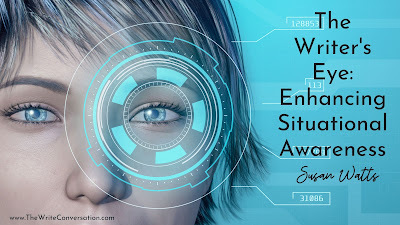
by Susan Watts
In the realm of self-defense, conventional wisdom often conjures images of physical prowess, strength, and combat techniques. However, a dimension exists beyond the physical aspects—a realm where creativity intertwines with martial arts, birthing a holistic approach to self-protection. As an author and a practitioner of martial arts, I find a fascinating synergy between these two worlds, where the artistry of the mind meets the discipline of the body.
Self-defense isn’t merely a series of movements or techniques—it's a mindset, a way of being. The canvas of self-defense expands beyond the training mat, extending into the creative corridors of our minds. To navigate this landscape effectively, one must embrace imagination, adaptability, and strategic thinking.
The foundation of self-defense is awareness—an acute understanding of one's surroundings, potential threats, and, most importantly, oneself. As creative individuals, we possess a heightened sense of observation, an innate ability to perceive nuances that others might overlook. For authors, situational awareness is pivotal for navigating the complexities of both the literary world and everyday environments.
You can uncover techniques for increasing your situational awareness with these valuable tips.
Observation Skills
Observation is key. Start by noting the finer details of your surroundings. This could be changes in the environment, people's behaviors, or anything out of the ordinary. As an author, this practice not only aids your descriptive skills but also helps in understanding the dynamics of various settings and assessing potential hazards. Pay close attention to non-verbal cues like body language and facial expressions. These can be useful in safeguarding yourself and providing nonverbal clues in your writing.
Stay Present and Engaged
In today's fast-paced world, distractions can be overwhelming, especially when fully engaged in the art of constructing worlds and characters. Nevertheless, it's essential to remain mindful in public or unfamiliar situations. Avoid getting lost in your thoughts or devices. Engage all your senses to create a comprehensive awareness of your environment. This heightened state of perception enriches not only your personal safety but also your writing, providing a richer sensory experience to draw from.
Assess Potential Risks
As writers, we often explore hypothetical scenarios. Use this skill in real life by assessing potential risks in different settings. What could go wrong? How would you respond? Identifying likely escape routes or safe zones is a practical aspect of this practice. This mindset doesn't mean living in fear, but being prepared.
Trust Your Intuition
Intuition is a powerful tool. If something feels off, it often is. Trusting your gut instincts means recognizing your subconscious awareness of potential danger in your environment. This skill can be crucial for an author's safety.
Maintain Awareness Online
In the digital age, situational awareness extends to cyberspace. Exercise caution when revealing personal information. Understand the risks of over sharing and be aware of cyber threats like phishing or scams, especially those targeting authors and creatives.
Stay Informed and Educated
Knowledge is power. Stay updated on current events, particularly those affecting the writing community. Understanding common threats, like online harassment or piracy, can help you navigate these challenges more effectively.
Practice Mindfulness and Meditation
Mindfulness and meditation can improve focus and awareness. These practices aid in maintaining a calm, present state of mind, essential for both observing your surroundings and enriching your writing.
Regularly Assess Your Environment
Make it a habit to continually scan and evaluate your environment. The key to this practice is being mindful without yielding to paranoia. Regular assessments can assist with remaining alert and prepared.
Seek Training or Guidance
Consider situational awareness or self-defense courses. These can offer practical guidance on improving observational skills and responding to potential threats.
Incorporating these steps into your routine as an author doesn't just contribute to personal safety; it can elevate your writing. Enhanced observation leads to more vivid descriptions, staying present helps in crafting authentic narratives, and understanding diverse scenarios adds depth to your storytelling. Situational awareness is an invaluable tool for authors, promoting safety and enriching your creative journey.
TWEETABLEThe Writer's Eye: Enhancing Situational Awareness from Susan Watts on @EdieMelson (Click to Tweet)
 Since her earliest recollections, Susan Watts has been crafting stories. As a child, she loved nothing more than opening a blank notebook and embarking on a new adventure through writing. While she enjoyed reading, creating her own stories brought her even greater joy. Under the pen name Michelle Allums, she authored a young adult urban fantasy titled, The Jade Amulet and is currently writing the sequel. Her short stories are also included in the anthologies Christmas Roses and Forever and Always. She will be a presenter in the upcoming writer’s symposium
“Polishing Your Mirror: Self-Care for Writers”
on March 23-24, 2024.
Since her earliest recollections, Susan Watts has been crafting stories. As a child, she loved nothing more than opening a blank notebook and embarking on a new adventure through writing. While she enjoyed reading, creating her own stories brought her even greater joy. Under the pen name Michelle Allums, she authored a young adult urban fantasy titled, The Jade Amulet and is currently writing the sequel. Her short stories are also included in the anthologies Christmas Roses and Forever and Always. She will be a presenter in the upcoming writer’s symposium
“Polishing Your Mirror: Self-Care for Writers”
on March 23-24, 2024. Susan has dedicated over four decades to training in multiple martial arts styles and holds the impressive title of a five-time US Karate Alliance world black belt fighting grand champion. Through her karate school, she is able to impart martial arts and life skills. Susan also incorporates her martial arts knowledge into her writing. An avid triathlete, she keeps in shape by running, biking and swimming. She lives in the country with her husband, where they raise animals and enjoy being outdoors. Susan also has three grown children and numerous grandchildren. In addition, she is a CPA and VP of finance for a company in her hometown.
Published on February 08, 2024 22:00
February 7, 2024
Let Me Count the Ways to Write About Love
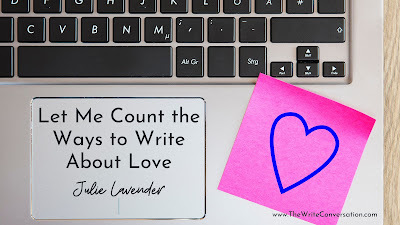
by Julie Lavender @JLavenderWrites
How do I love thee? Let me count the ways ….
February is the month of all-things love. If you’re looking for a new writing idea, say, for a blog post or newsletter, essay or short story, or future, I think you’ll LOVE some of the ideas below.
The Word
For obvious love-inspired ideas, look no further than the One who first loved us. Pick one of these verses as the focal point of your writing and write a devotion that points to the Heavenly Father.
* John 3:16 – For God so loved the world, that he gave his only Son, that whoever believes in him should not perish but have eternal life.
* Romans 5:8 – But God shows his love for us in that while we were still sinners, Christ died for us.
* 1 John 3:1 – See what kind of love the Father has given to us, that we should be called children of God, and so we are.
* 1 John 4:16 – So we have come to know and to believe the love that God has for us. God is love, and whoever abides in love abides in God, and God abides in him.
* 1 John 4:19 – We love because he first loved us.
* Zephaniah 3:17 – The Lord your God is in your midst, a mighty one who will save; he will rejoice over you with gladness; he will quiet you by his love; he will exult over you with loud singing.
The Calendar
Here’s a few silly, but actual holidays to consider for a creative writing idea.
February:
* Doggy Date Night
* National Wedding Ring Day
* Rose Day
* National Marriage Week
* International Flirting Week
* Hug Day
* Kiss Day
* Valentine’s Day
* National Love Your Pet Day
March:
* National Pig Day (what’s not to love about pigs?)
* World Compliment Day
April:
* Couple Appreciation Month
* National Love Our Children Day
* Kiss Your Mate Day
May:
* Date Your Mate Month
* National Teen Self-Esteem Month
* Global Love Day
* Teacher Appreciation Week
* Poem on Your Pillow Day
June:
* Say Something Nice Day
* National Hug Your Cat Day
* National Best Friends Day
July:
* Global Forgiveness Day
* National Cousins Day
* National Aunt and Uncle Day
* National Love is Kind Day
*International Day of Friendship
August:
* American Family Day
* National Hand Holding Day
* Kiss and Make Up Day
September:
* Locate an Old Friend Day
* Love Note Day
* National Love People Day
October:
* National I Love You Day
November:
* Kindness Week
* Family Volunteer Day
December:
* Jesus’ Birthday
January:
* World Day of Peace
* National Cuddle Day
The Family
Use those most dear to you to encourage LOVELY ideas for writing work. Consider a few topics like this:
* 4 Ways to Remind Your Teen How Much They Are Loved
* A Dozen Ways to Tell Your Husband He’s Loved Without Using Words
* 12 Suggestions for Showing Your Wife She’s Appreciated
* 5 Tips to Encourage Your Child to Love One Another
Use the month of love to spark creative writing ideas. Brainstorm ideas while love is in the air, write your heart out, and file the extras for future needs.
Happy February!
TWEETABLELet Me Count the Ways to Write About Love - @JLavenderWrites on @EdieMelson (Click to Tweet)
 Julie Lavender is excited that her children’s books release this year. A children’s picture book with End Game Press and four educational children’s books co-authored with her husband.release in the fall. She’s also excited about the release of two books since October: the bilingual edition of her award-winning, Amazon bestselling, Children’s Bible Stories for Bedtime and Strength for All Seasons: A Mom’s Devotional of Powerful Verses and Prayers
Julie Lavender is excited that her children’s books release this year. A children’s picture book with End Game Press and four educational children’s books co-authored with her husband.release in the fall. She’s also excited about the release of two books since October: the bilingual edition of her award-winning, Amazon bestselling, Children’s Bible Stories for Bedtime and Strength for All Seasons: A Mom’s Devotional of Powerful Verses and Prayers
Published on February 07, 2024 22:00
February 6, 2024
How a Writer's Feelings Feed into What We Write
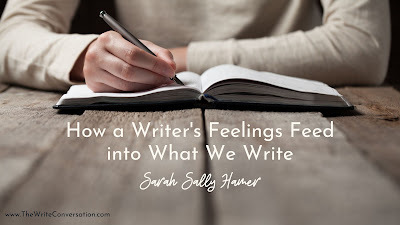
by Sarah Sally Hamer @SarahSallyHamer
What do you feel?
As writers, we often spend a lot of time digging into a character and their emotions. After all, emotions are an important part of the human experience and the use of them in writing helps readers to identify with a character and what they do.
But we humans often pay little attention to our own emotions.
What we feel—what we express—are like tiny windows into our minds and our hearts. Emotions give us an explanation as to how we think, trauma experiences, and how we interact with other people.
For instance, I have a terrible temper. Not many people have ever seen it—thank goodness!—because it's venomous and vitriolic and lethal. Well, maybe not lethal since I've never killed anyone, even when I'm in a rage. But I've been told it's truly a sight to behold. I really don't know because, when I'm that angry, all I can see is a haze of red mist. Regardless, I have almost no control over it, once I've gotten there.
But the beauty of being that angry is, once I've ridden the roller coaster of the emotion, it opens the door to analysis. Luckily, I have a great psychologist friend who has helped me find the source of my wrath and we've worked through layers and layers of frustration and bad experiences of my childhood. So, over the years, the episodes have become less and less frequent.
That's why the expression of emotions can be so helpful. Of course, blind rage isn't necessarily the best one to start with. But we can use our actions and reactions as guides to look inside ourselves and discover why we do the things we do.
Logic is simply a process in the brain. We are stimulated by an outside sensory vibration and brain cells start to vibrate in resonance. Each brain cell is connected in clusters to millions of other brain cells, all vibrating at the same frequency. We call that being in resonance with the idea working in our brain at that moment. Each of these cells are vibrating with the rest in the cluster, even if some are not as prevalent as another—they are "old memories." Some are classified as good or bad, hurtful or joyous but, ultimately, they are all connected. (I recommend the movie, Inside Out to see a beautiful explanation of how the brain works.)
So, whether we remember it consciously or not, these memories mean something to us. No matter what, we react in the same way as we've always done: I see that (whatever) or smell that (whatever), or hear that (whatever) and my body reacts with a feeling. It's an emotional reaction to something that's not new, even if something new has triggered it. And we may have no idea why. The situation been stored in our brain, probably since early childhood. New triggers and brain cells have been created over the years, adding new impetus to a reaction. They are all triggered by the outside stimulus that stirs up the pot once again.
We have feelings and, somehow in our bodies or outside world, we express them. Anger, tears, warm feelings of love, nervousness, etc., etc., etc.
So we use logic to deal with it, right? But it may not help because logic leads us right back to the same place we started—our logic is based upon our basic concepts, the ball of interconnected wires in our brain that all vibrate according to what we believe. We think we're thinking but, actually, we're just reacting. Over and over and over. That's why we continue to react in the same way under certain conditions. Over and over and over.
If your image, for example, is to eat healthy food, then when you open the fridge, there should be healthy food choices inside. We need to make healthy choices at the grocery store. In fact, I have to avoid almost all of the entire middle because those aisles are where, at least in my store, the danger of not meeting your goals lives—I have to shop around the edges.
Maybe your image is to create healthy relationships in your life. I have a friend who is currently on her fifth marriage and she's really unhappy about the current one. From what she tells me, all five guys are exactly alike. Why does she keep attracting the same type of relationship?
So, since our brain is both hard-wired and very willing to give us what we say we want, maybe making our images a little clearer and then sticking to them will help. Some ideas:Stop and think about your choices! Step away from temptation. You don't have to clean out your fridge but it would certainly reduce the "oh, it won't make a difference this one time" excuse. Check those relationships out before you jump in.Take a different approach. Make a list for your groceries and stick to it. Order your food on line so there's less impulse buying. Plan your meals so that you don't get so hungry you'll eat easy things. Don't be in a hurry to get into a relationship. The best ones may be ones that take time to grow.
Ultimately, we can work through our negative emotions and find a better way to live.
How about you? What do you have in your fridge?
TWEETABLEHow a Writer's Feelings Feed into What We Write from @SarahSallyHamer on @EdieMelson (Click to Tweet)
Learn more from Sally Hamer, Margie Lawson, Edie Melson and four other amazing writers by attending the “Polishing Your Mirror: Self-Care for Writers” Symposium, March 23-24, 2024. Visit MindPotential.org for more info!
 Sarah (Sally) Hamer, B.S., MLA, is a lover of books, a teacher of writers, and a believer in a good story. Most of all, she is eternally fascinated by people and how they 'tick'. She’s passionate about helping people tell their own stories, whether through fiction or through memoir. Writing in many genres—mystery, science fiction, fantasy, romance, medieval history, non-fiction—she has won awards at both local and national levels, including two Golden Heart finals.
Sarah (Sally) Hamer, B.S., MLA, is a lover of books, a teacher of writers, and a believer in a good story. Most of all, she is eternally fascinated by people and how they 'tick'. She’s passionate about helping people tell their own stories, whether through fiction or through memoir. Writing in many genres—mystery, science fiction, fantasy, romance, medieval history, non-fiction—she has won awards at both local and national levels, including two Golden Heart finals.A teacher of memoir, beginning and advanced creative fiction writing, and screenwriting at Louisiana State University in Shreveport for over twenty years, she also teaches online for Margie Lawson at WWW.MARGIELAWSON.COM. Sally is a free-lance editor and book coach at Touch Not the Cat Books, with many of her students and clients becoming successful, award-winning authors.
You can find her at INFO@MINDPOTENTIAL.ORG
Published on February 06, 2024 22:00
February 5, 2024
The First Paragraph Leads to the First Chapter
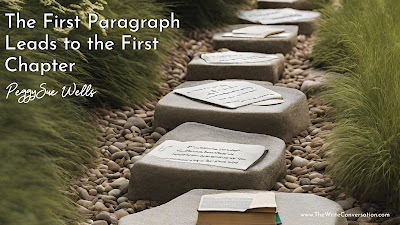
by PeggySue Wells @PeggySueWells
Take a look at your manuscript. Does your first line compel the reader to take in the first paragraph? Is the opening paragraph an incentive to read the first chapter?
RememberYour first line prompts the reader to read the first paragraph.The first paragraph compels the reader to read the first chapter.The first chapter invites the reader to finish the book.The last chapter sells your next book.I cringe when writers show me their work and they have written to the reader, “Don’t stop reading, you’ll see why later.” Or, “Stay with me, it will be worth it.” Or, “Keep turning pages to find out …”
An author’s first job is to elicit emotion in the reader. We create work that a reader feels is worth an investment of their time and money. Rather than ask the reader to hang on until they have a reason to keep reading, move to the beginning the parts that compel them to turn pages.
Like us, readers come to a piece of writing with several questions.What’s in this for me?Why should I care?Is this believable?Can I trust this author will deliver a story as good as promised?With an interesting first sentence in place, pen an opening paragraph that stirs curiosity in the reader to discover what is to come. What questions does the first paragraph ask in these first paragraphs? Would you keep reading?In the beginning God created the heaven and the earth. And the earth was without form, and void; and darkness was upon the face of the deep. And the Spirit of God moved upon the face of the waters. ~ The BibleNikki, the name we finally gave my younger daughter, is not an abbreviation; it was a compromise I reached with her father. For paradoxically it was he who wanted to give her a Japanese name and I – perhaps out of some selfish desire not to be reminded of the past – insisted on an English one. ~ A Pale View of Hills by Kazuo IshiguroThis was an extraordinary mission. No presidential aides had ever done what they were about to do. J. Fred Buzhardt and Leonard Garment settled into their first-class seats on Eastern flight 177 from Washington D.C. to Miami. They had reached an inescapable conclusion and had reviewed the reasons over and over. Garment had a list on a yellow legal pad–now twenty-two or twenty-three items. It was a bleak and very unpleasant business. ~ The Final Days by Bob Woodward and Carl BernsteinLittle Ruth felt herself being shaken. She opened an eye. Six-year-old June leaned over her, the sleeves of her red robe dragging against Ruth’s quilt. “Get up! Santa’s been here!” ~ The Sisters of Summit Avenue by Lynn CullenI watched the headlights bounce up and down our long, bumpy driveway. They took forever to arrive, but only because I was so excited. ~ The Mysterious Matt Barnes by Matthew Weigelt Anything could happen while the dead slept. Which was why some would say a woman shouldn’t tread alone through a cemetery at 2:55 on a Tuesday morning in April. But possible danger had never stopped Houston FBI Special Agent Tori Templeton, especially when her mind marched with determination. Her body refused to give in to rest, but it wasn’t a violent crime robber her of sleep. ~ Deep Extraction by DiAnn MillsAs the graveyard fell dark into the shiver of the canyon’s breath, the sexton, with the arduous motion of arthritic hands, donned his coat, hat, scarf, lit the wick of a candle-lantern, then emerged from his cottage into the snow-draped graveyard to chain the cemetery’s gates against threat of grave robbers.~ The Letter by Richard Paul EvansOnce a piece is complete, many authors return to the first paragraph. When a project is finished, the writer has learned more about their story and can polish the opening paragraph to elicit emotion in the reader.
Does your first line compel the reader to continue through the first paragraph? Does the first paragraph lead the reader to invest time in the first chapter? Will the first chapter propel the reader to complete the book? Will the reader close this book and immediately look for the next by the same author?
TWEETABLEThe First Paragraph Leads to the First Chapter, insight from @PeggySueWells on @EdieMelson (Click to Tweet)
 Tropical island votary and history buff, PeggySue Wells parasails, skydives, snorkels, scuba dives, and has taken (but not passed) pilot training. Writing from the 100-Acre Wood in Indiana, Wells is the bestselling author of thirty books including The Slave Across the Street, Slavery in the Land of the Free, Bonding With Your Child Through Boundaries, Homeless for the Holidays, Chasing Sunrise, and The Ten Best Decisions A Single Mom Can Make. Founder of SingleMomCircle.com, PeggySue is named for the Buddy Holly song with the great drumbeat. At school author visits, she teaches students the secrets to writing and speaks at events and conferences. Connect with her at www.PeggySueWells.com, on Facebook at PeggySue Wells, and LinkedIn at linkedin.com/in/peggysuewells
Tropical island votary and history buff, PeggySue Wells parasails, skydives, snorkels, scuba dives, and has taken (but not passed) pilot training. Writing from the 100-Acre Wood in Indiana, Wells is the bestselling author of thirty books including The Slave Across the Street, Slavery in the Land of the Free, Bonding With Your Child Through Boundaries, Homeless for the Holidays, Chasing Sunrise, and The Ten Best Decisions A Single Mom Can Make. Founder of SingleMomCircle.com, PeggySue is named for the Buddy Holly song with the great drumbeat. At school author visits, she teaches students the secrets to writing and speaks at events and conferences. Connect with her at www.PeggySueWells.com, on Facebook at PeggySue Wells, and LinkedIn at linkedin.com/in/peggysuewells
Published on February 05, 2024 22:00



